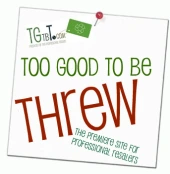 How to present a store full of… well, LOTS of STUFF. Great question came into my mailbox! And it came another time too!
How to present a store full of… well, LOTS of STUFF. Great question came into my mailbox! And it came another time too!
I have an odd question for you. Me and my assistant can’t seem to agree to people prefer a shop that’s neat and tidy or a Thrift Shop that is full and cluttered? Could you shed some light on the subject? –Kenneth Droneburg Seton Family Store, Manager, http://www.setoncenterinc.org
Hi Kenneth,
I think it depends on your price level. The higher-priced your goods (and your clientele) the neater it has to be…
THAT SAID, there are some exceptions? caveats?
* Neater / tidier does NOT mean organization: “all the ashtrays here, all the salt-and-peppers there.” Neater means clean, dusted, price tags visible.
* “Crowded” is a relative term… yes, enough space so things can be picked up and put down with breakage…. but not so much that the place looks sterile and empty.
* Any price level would benefit if they’d arrange by lifestyle: all the sea shore themed things here (sea shell encrusted frame displayed on the blue painted shabby coffee table, and the lobster-crackers there too) and all the Goth things there (brocade armchair, black enamel reading lamp, blood-red goblets) and so on.
* ALL thrifts, large or small, neat or cluttered, need to have a “Treasure Trove” corner with dead-right bargains. This could be a “man-cave” of repairable electronics and bits-and-pieces, it could be a “The Other Season” section with wrong-season clothes and knick-knacks, it could be simply a clearance corner with stuff that’s priced under a certain set limit (dollar store? Quarter Store? Five-and-dime?)
… you probably have 4 corners in your store, try ’em all!
Kenneth wrote back later:
Kind of a tricky questions for you. What’s your thoughts or suggestion of keeping a second hand shop from looking too junky or messy looking. Also do you feel second hand stores should have its shelves or racks filed to where people go to treasure hunt or to were there neatly displayed and organized??
Here’s my second answer:
Not tricky, but complicated 🙂
Here’s a start: https://tgtbt.blog/2010/10/10/whats-the-difference/ and a little mini-series starting here https://tgtbt.blog/2010/08/23/the-4-steps-to-freshen-up-a-resale-shop/ which is more about your physical plant than the placement of merchandise.
Re merchandise: Of course you’ve read in the manual about colorizing clothes on hangers. It’s AMAZING how this makes the store look better.
As for goods on shelves? I am a proponent of arranging these by “story” before “use”… e.g. all the Mid-Century sitarounds rather than all the ashtrays here and the lamps there. Reason? People are treasure hunting. Seldom come in specifically for an ashtray.
Of course, there ARE things (and sometimes times) when you’d do categories, for example small appliances all in one place, and even the toasters next to other toasters… because this is an item they WOULD specifically be hunting for, and they’ll want to see your “full range” of toasters before they decide.


As an antique/resale co-op, the comment I hear most often about our place is, “I just love coming here because everything is so clean”. We try our best to be clean & somewhat uncluttered. As a co-op of 50 vendors, that’s not always the easiest thing to accomplish, but our customers notice & appreciate it.
As a small artisan gallery and consignment shop, we couldn’t agree more with your suggested merchandising methods. We have had more than one compliment that went toward easy access to items, lack of clutter, and a well juried inventory. Now to double check that all our tags are easily visible…
🙂 Thanks Kari… it’s so true, visible price tags lead to a LOT less “oops, I don’t mean to break that…”